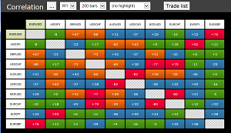1. About correlation
The Correlation Matrix shows the correlation between symbols over a configurable time-frame and number of bars, for example the last 100 H1 bars.
Correlation is measured on a scale from -100 to +100:
Get notifications about events on your account, and in the market
Take automatic actions when events occur
Send automatic updates to your followers via Twitter, email, or SMS
Correlation can have a major effect on your trading risk. For example the following charts show H1 EURUSD and USDCHF over the same time period:


These symbols had very strong negative correlation (about -95). If you were long EURUSD and short USDCHF over this period, or vice versa, then you would have seen very similar profits on both positions. In effect, you did not have two positions: you only really had one position. (If you were long both symbols, or short both symbols, then you probably had a profit on one and a matching loss on the other.)
It is generally advisable to minimise the correlation between your open positions. Otherwise, you are either trading the same price action twice over, or you have two positions which cancel each other out.
The Correlation Matrix helps you to identify symbols with strong or weak correlation.
2. Using the Correlation Matrix
The Correlation Matrix shows the correlation between a grid of selected symbols. For example:

Each cell in the matrix is color-coded:

It makes little difference whether values are positive or negative (e.g. +90 or -90), and the meaning depends on whether you are long or short each symbol. For example:
+90. If you are long both symbols, or short both symbols, then you will tend to see identical profits or losses on both positions. If you are long one symbol and short the other, then you will tend to have a matching profit and loss.
-90. If you are long both symbols, or short both symbols, then you will tend to have a matching profit and loss. If you are long one symbol and short the other, then you will tend to see identical profits or losses on both positions.
The chequered cells show rows and columns which are the same (i.e. correlation of EURUSD against itself is meaningless). The grid is symmetrical either side of the chequered line: e.g. the correlation of EURUSD against USDCHF is the same as the correlation of USDCHF against EURUSD.
2.2 Changing the parameters for the calculation
You can use the fields at the top of the matrix to choose a timeframe (e.g. H1, D1) and a number of historic bars (e.g. 25, 100, 500).
Correlation between symbols changes over time, and recent correlation may not continue in future. As a general rule, the settings which you choose should be related to how long you intend to keep open positions for. For example, if you expect a position to be open for 24 hours, you might want to look at H1 correlation over the last 50 or 100 bars (roughly 2 or 4 days).
You can choose which symbols to include in the Matrix by using the … button. This shows the list of symbols which are currently being displayed, and a list of all available symbols.
2.3 Highlighting correlation strength
The strength field, next to the bars field, lets you highlight different types of correlation in the grid. For example, if you pick “Strong” then the grid highlights correlation above ±75, and grays out all weaker correlations.
2.4 Trade list
The Trade List button shows the average correlation between a list of selected symbols – for example, positions you are currently trading, or positions which you intend to open in future. The list shows the average correlation, and also marks any symbols which have strong correlation with another symbol on the list. In the following example the overall average is weak correlation, but AUDUSD and NZDUSD have strong correlation with each other:

 Akses ke 10.000+ instrumen finansial
Akses ke 10.000+ instrumen finansial Buka & tutup posisi secara otomatis
Buka & tutup posisi secara otomatis Kalender berita & ekonomi
Kalender berita & ekonomi Grafik & indikator teknikal
Grafik & indikator teknikal Menyediakan banyak perangkat trading
Menyediakan banyak perangkat trading
Dengan memberi email Anda, Anda menyatakan menyetujui kebijakan privasi FP Markets dan bersedia menerima materi pemasaran dari FP Markets. Anda dapat berhenti berlangganan kapan saja.
Source - database | Page ID - 23734